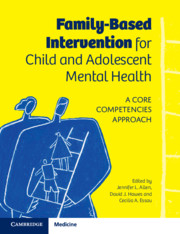Book contents
- Family-Based Intervention for Child and Adolescent Mental Health
- Family-Based Intervention for Child and Adolescent Mental Health
- Copyright page
- Contents
- Contributors
- Preface
- Part I Theoretical Perspectives on Family-Based Intervention
- Part II Core Clinical Competencies
- Part III Family Intervention for Specific Child and Adolescent Mental Health Problems
- Chapter 8 A Family-Based Approach to the Treatment of Youth Depression
- Chapter 9 A Family-Based CBT Approach to the Treatment of Anxiety Disorders in Children and Adolescents
- Chapter 10 Case Complexity and Resistance to Change in the Treatment of Child Conduct Problems
- Chapter 11 Enhancing Engagement and Motivation with Adolescents with ADHD and Their Parents
- Chapter 12 Functional Family Therapy for Antisocial Behaviour in Adolescents
- Chapter 13 Autism Spectrum Disorders in Young Children
- Chapter 14 Family-Based Treatment for Eating Disorders
- Chapter 15 Sleep Problems
- Part IV Family Intervention for Children at Risk Due to Family Dysfunction or Past Adversity
- Part V New Developments in Family-Based Intervention
- Index
- References
Chapter 12 - Functional Family Therapy for Antisocial Behaviour in Adolescents
from Part III - Family Intervention for Specific Child and Adolescent Mental Health Problems
Published online by Cambridge University Press: 18 February 2021
- Family-Based Intervention for Child and Adolescent Mental Health
- Family-Based Intervention for Child and Adolescent Mental Health
- Copyright page
- Contents
- Contributors
- Preface
- Part I Theoretical Perspectives on Family-Based Intervention
- Part II Core Clinical Competencies
- Part III Family Intervention for Specific Child and Adolescent Mental Health Problems
- Chapter 8 A Family-Based Approach to the Treatment of Youth Depression
- Chapter 9 A Family-Based CBT Approach to the Treatment of Anxiety Disorders in Children and Adolescents
- Chapter 10 Case Complexity and Resistance to Change in the Treatment of Child Conduct Problems
- Chapter 11 Enhancing Engagement and Motivation with Adolescents with ADHD and Their Parents
- Chapter 12 Functional Family Therapy for Antisocial Behaviour in Adolescents
- Chapter 13 Autism Spectrum Disorders in Young Children
- Chapter 14 Family-Based Treatment for Eating Disorders
- Chapter 15 Sleep Problems
- Part IV Family Intervention for Children at Risk Due to Family Dysfunction or Past Adversity
- Part V New Developments in Family-Based Intervention
- Index
- References
Summary
Functional family therapy (FFT) is an integrated model that combines family systems and cognitive behavioural theories into a coherent relationship-based approach for working with young persons with externalizing problems and their families. FFT is an evidence-based model that has been supported in numerous controlled research studies and community-based evaluations. In-session process research has also shed light on the clinical interior of treatment, and findings from this research have helped shape the articulation of the core principles and techniques of the model. FFT proceeds through five distinct phases of treatment: engagement, motivation, relational assessment, behaviour change and generalization. Each phase has specific goals, focus, activities and skills. The principles of FFT are consistent with many of the features of core competencies approaches in cognitive behavioural therapy. In this chapter, we describe research on FFT that has led to the inclusion of elements that are considered core competencies. A detailed overview of the FFT clinical model is provided, as are specific examples of techniques or clinical focus that are consistent with a core competencies framework.
- Type
- Chapter
- Information
- Family-Based Intervention for Child and Adolescent Mental HealthA Core Competencies Approach, pp. 152 - 165Publisher: Cambridge University PressPrint publication year: 2021



